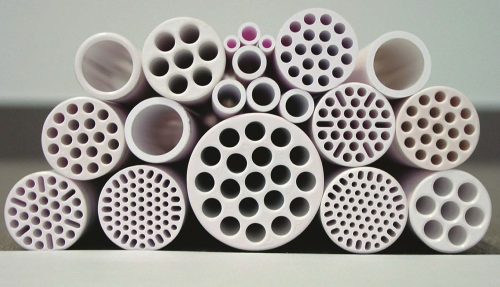
Video: Cleaning wastewater effectively.
Ceramic membranes offer an energy efficient mechanical separation technology for cleaning wastewater for reuse. However, the technique has been limited to molecules of 450 Daltons or more. Dr Ingolf Voigt, Dr-Ing. Hannes Richter and Dipl.-Chem. Petra Puhlfuerss from Fraunhofer IKTS in Hermsdorf, Germany, report that they have now produced membranes which can relably filter out dissolved organic molecules with a molar mass of only 200 Daltons.
"With our ceramic membranes, we achieve, for the first time, a molecular separation limit of 200 Daltons – and, thereby, a whole new quality," says Voigt, Deputy Institute Director of the IKTS and Site Manager in Hermsdorf. Several obstacles had to be overcome to achieve this result. The first involved the production of the membrane itself. To separate such small molecules reliably, a membrane was needed with pores smaller than the molecules to be separated. The Fraunhofer team has developed a nanofiltration membrane with pores of <1 nanometre. If a liquid is filtered through these pores only water will pass through, leaving behind much of the dissolved molecules and some salts. The membrane can even filter out substances like antibiotics and hormones which are still present in drinking water.
In addition, all of the pores had to be as similar in size as possible, since a single larger opening is sufficient to allow molecules through.
"We achieved these results by refining sol-gel technology," reports Richter, Head of Department at the IKTS.
The second hurdle was to make such membrane layers defect-free over larger surfaces.
"Whereas only a few square centimeters of surface are usually coated, we equipped a pilot system with a membrane area of 234 square meters, which means that our membrane is several magnitudes larger," explains Puhlfuerss, scientist at the IKTS.
Pilot plant
The ceramic membrane is robust and can withstand heat and chemicals, making it suitable for wastewater processing in oil production. A pilot plant commissioned by Shell in Alberta, Canada, and built by Andreas Junghans – Anlagenbau und Edelstahlbearbeitung GmbH & Co. KG of Frankenberg, Germany, has been successfully purifying wastewater since 2016, which is used for the extraction of oil from oil sand.
The researchers are currently planning an initial production facility with a membrane area of more than 5000 m2. Any kind of water can be purified, including surface water, and water from wells or rivers. Heavy metals and dissolved organic substances from agricultural applications can be also removed, for example, herbicides which might have been carried to the surface water. For the development of the ceramic nanofiltration membrane, Voigt, Richter and Puhlfuerss have received this year’s Joseph-von-Fraunhofer award.


